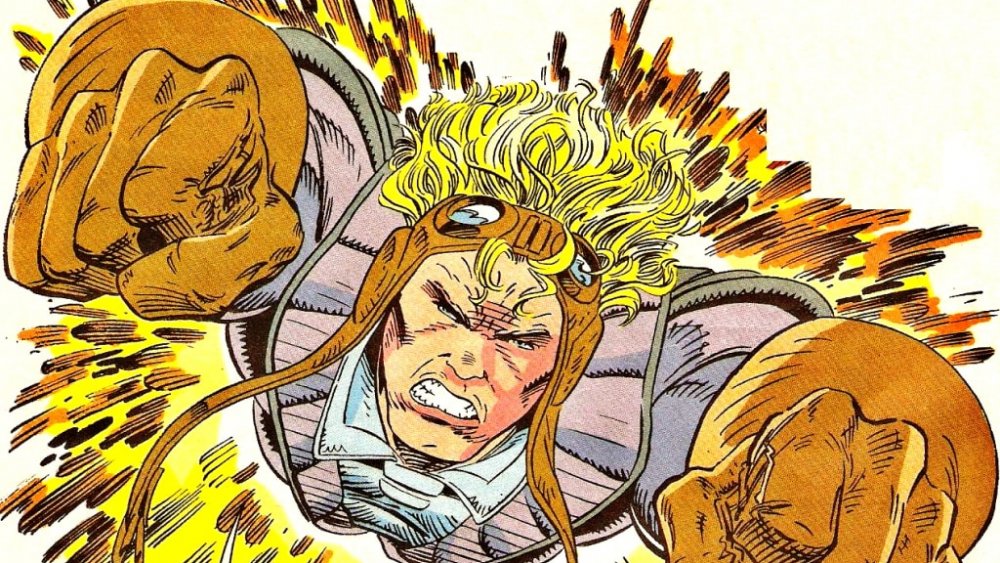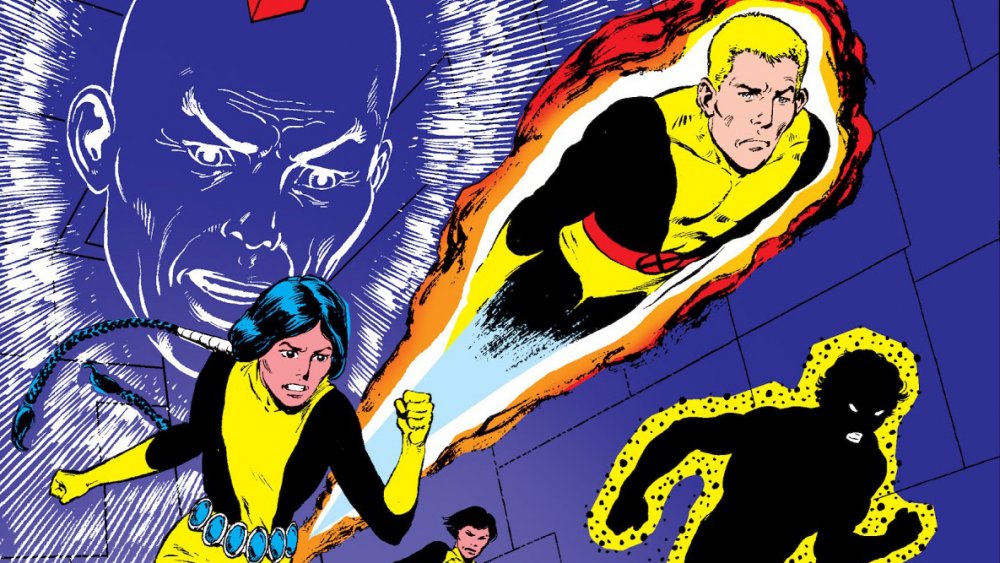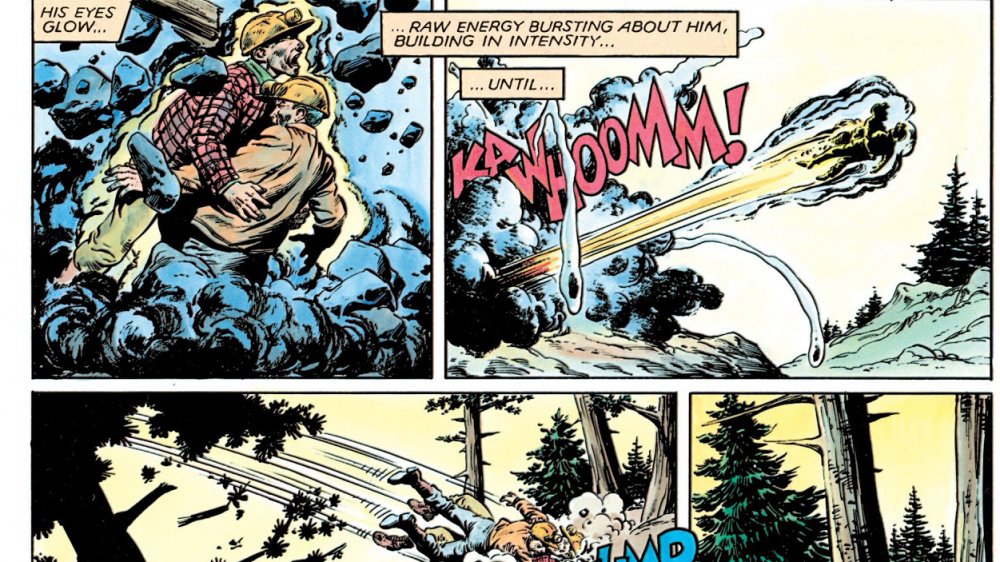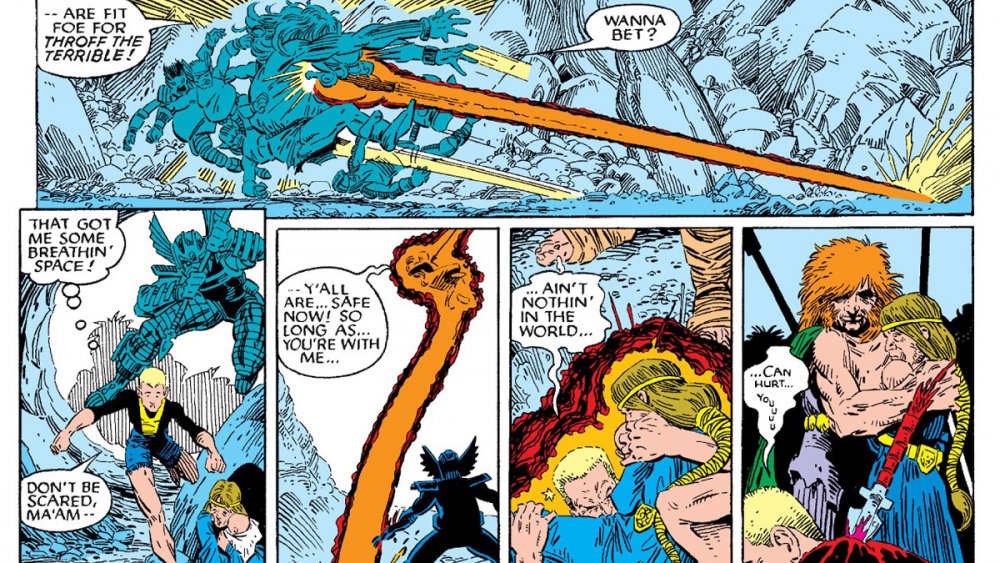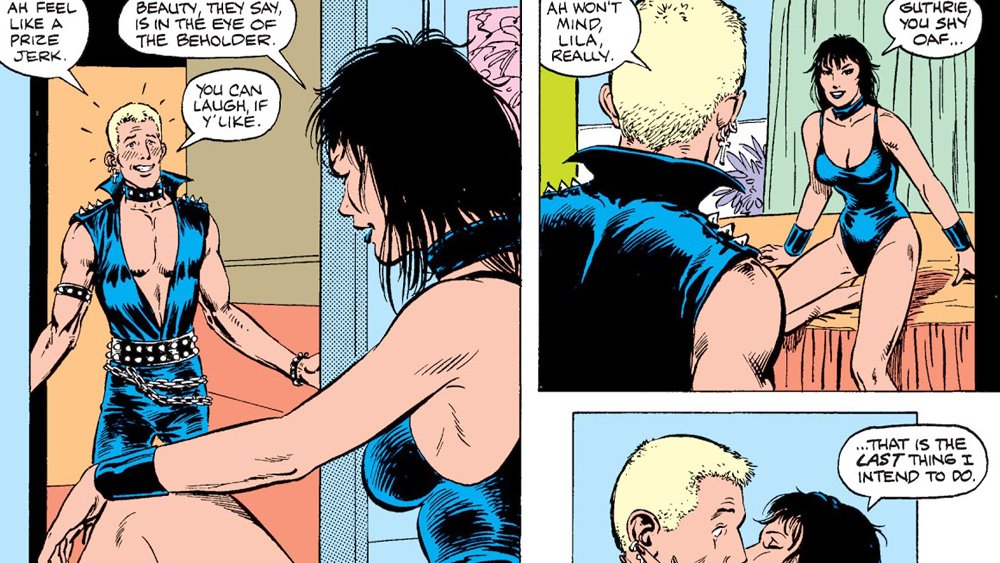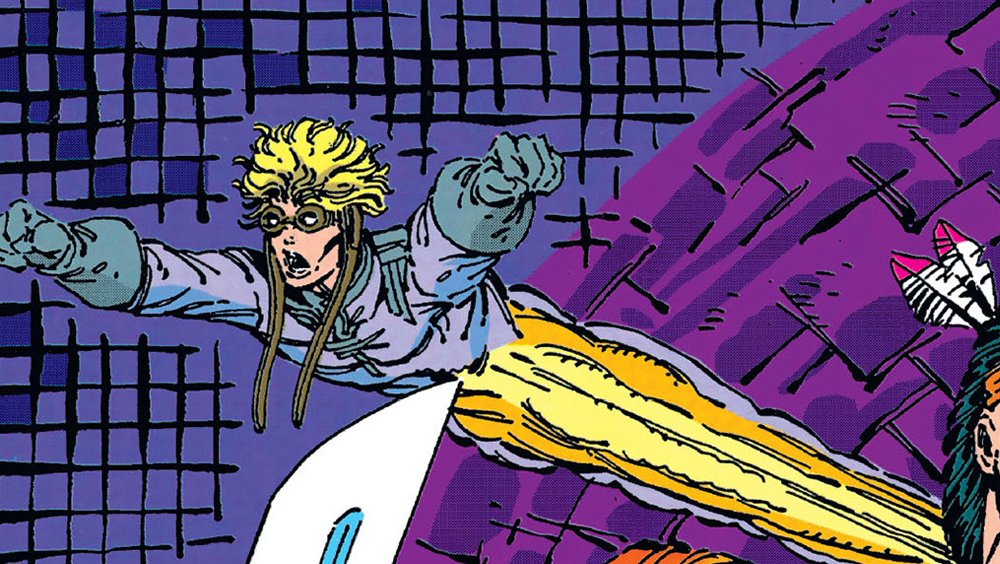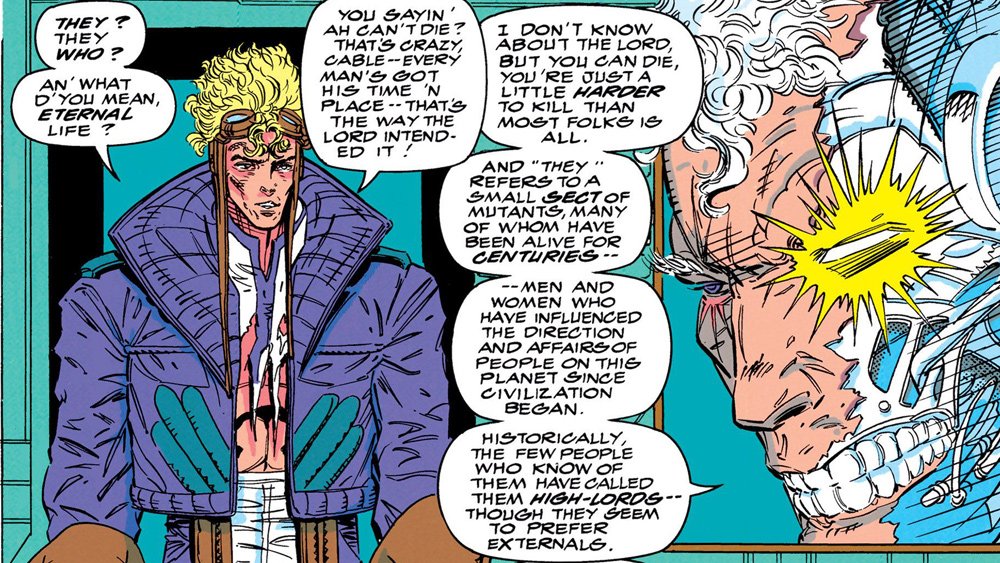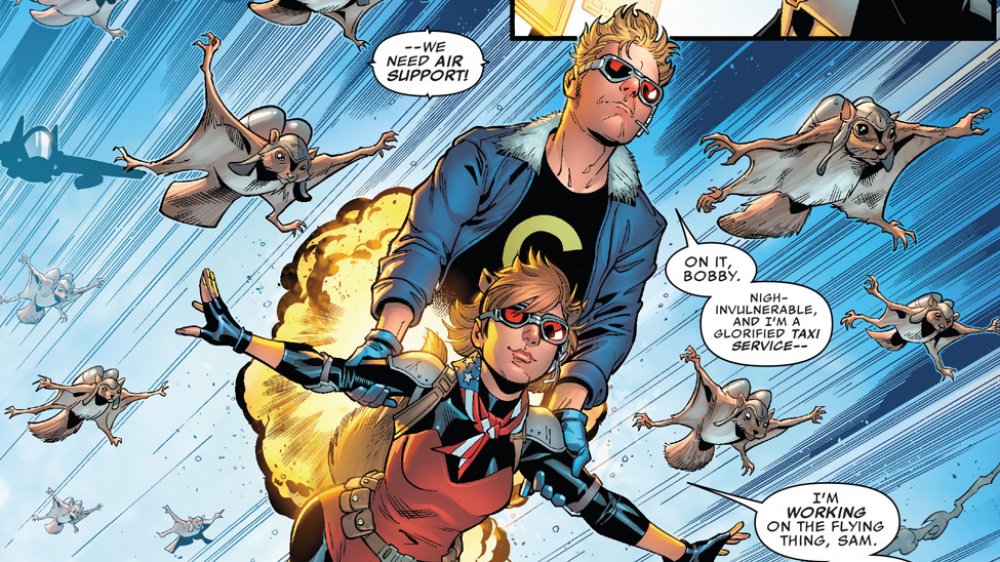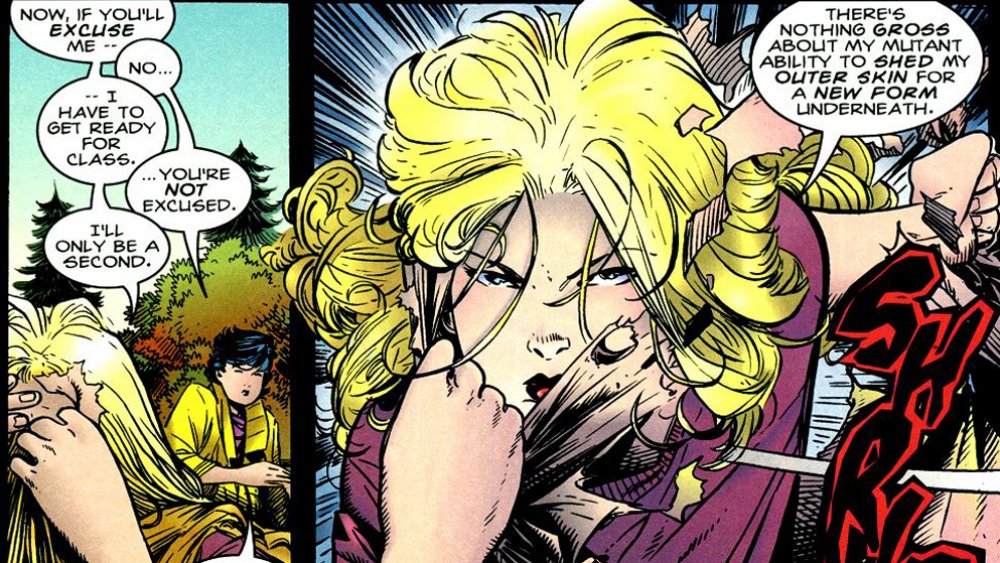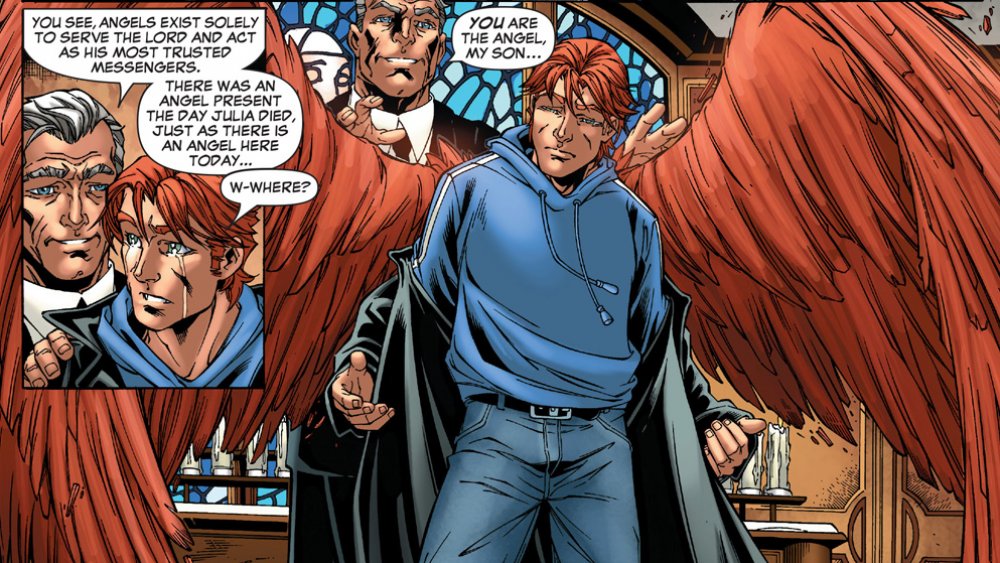The Untold Truth Of Cannonball
When you think of Marvel's mutant heroes, your mind probably goes to the cool ones. A world-weary tough-guy Canadian samurai with claws that can cut through anything. A smooth-talking Cajun con-man who can make anything explode with a touch. A living goddess who can command the weather itself, with thunder, lightning, and devastating winds at her command. These are the characters that define the X-Men, and show the everlasting appeal of the franchise.
You might not think about the characters with slightly less cool powers, like, say, propelling themselves through the air on what appears to be exploding hindquarters, but that doesn't make them any less important and beloved. Case in point: Sam Guthrie, better known as Cannonball. Since his introduction in 1982, he's been at the center of some of the X-Men's wildest, strangest, and most compelling stories, and despite having one of the most straightforward powers in comics, his history is as complicated as they come. Here's the truth behind the nigh-invulnerable, blastin' hero of the New Mutants, Cannonball.
The Newest Mutant
In the early '80s, the X-Men were in the dead center of a long and extremely profitable reign as the biggest thing in comics. Legendary stories like the "Dark Phoenix" saga and the time-bending "Days of Future Past" had cemented the team as having a scope that was truly epic, while the ongoing superhero soap opera kept readers hooked with a web of relationships and heartache that ran through the stories. These years unquestionably brought some of the most important comics in Marvel's long history — arguably some of the most important comics ever, period — but along the way, something about the X-Men had been lost.
As originally created by Stan Lee and Jack Kirby in 1963, the X-Men were based around a school where teenage mutants could learn to hone their powers between their missions as a superhero team. By 1975 and Chris Claremont and Dave Cockrum's introduction of the "All-New, All-Different" X-Men — you know, the team that had Wolverine, Storm, Nightcrawler, and a handful of other characters that you think of when you hear the word "X-Men" — that had changed. Sure, they had a single teenager hanging around in the form of superhero trainee Kitty Pryde, but the rest of the team were adults who had very adult problems, like dealing with the mistakes they'd made in the past, or being seduced by Dracula.
Marvel had been built on the backs of coming-of-age teen superhero stories thanks to characters like Spider-Man, and with the merry mutants of the X-Men becoming the hottest thing in the industry, that probably seemed like a good thing to revisit. The only problem was that Uncanny X-Men itself was too popular to take a step backwards. If they were going to do a story with teenage X-Men, they'd need some new mutants... which is exactly what Claremont and artist Bob McLeod did in the appropriately titled Marvel graphic novel The New Mutants.
Misspent youth
The setup for the New Mutants graphic novel was a simple throwback to the early days of the X-Men, mixed with the international flavor that had made the "All-Different" team such a success. Teenagers from across the world realized that they had mutant powers, and came to Charles Xavier's School For Gifted Youngsters to learn how to control them. Or at least, most of them did. Sam Guthrie, on the other hand, took a slightly different path to Professor X's doorstep, and it started when he was recruited to the other side.
When his powers manifested, Sam was still living in the fictional Cameron County, Kentucky. At only 16, he'd dropped out of school to work in an Appalachian coal mine to provide for his mother and nine brothers and sisters when his father died. Unfortunately, his first day at work involved a cave-in that trapped him and a coworker named Lewis under tons of rubble. The good news was that Sam was, of course, a mutant, and his "blastin'" power, triggered when his "legs seemed to explode" and propelled him through the air inside a nigh-invulnerable force field, allowed him to free himself and save Lewis in the process.
The bad news? The coal mine was owned by Donald Pierce, a name that X-Fans recognize as the mutant-hating cyborg that the X-Men had faced off against when they took on the Hellfire Club. In a twisted effort to get revenge, Pierce recruited Sam before Xavier could, taking advantage of the otherwise decent young man's poverty by giving him a huge salary — and, crucially, not informing Sam that he would murder him once he'd outlived his usefulness. Sam only really caught on to what was happening after Pierce ordered him to kill the other mutants, which is pretty weird when you consider that he was talking to a racist cyborg dressed like a 19th-century dandy in a room that contained a Kill Professor X machine. Cannonball is many things, but "perceptive" has never been one of them.
Team player
It wasn't long before Sam Guthrie had his face turn. By the end of the New Mutants graphic novel, he'd shown up at the X-Mansion to join the team, and when the New Mutants ongoing series launched the following year, he was part of the core cast. He'd remain with the team for the entirety of existence — and stick around for most of its future incarnations, too — and would even become the co-leader alongside Dani Moonstar.
It's worth noting that Sam's adventures alongside the New Mutants were weird, even by Marvel standards. In fact, they're weird even by X-Men standards, and considering that we don't really talk about that time that Cyclops fought a bunch of leprechauns anymore, that's saying something. Through it all, though, Sam's innate friendliness and decency remained a constant, and made him one of the characters most likely to make friends as they bopped around the Marvel Universe.
When they wound up in Thor's home of Asgard, for instance, Sam struck up a seemingly unlikely friendship with Eitri the Dwarf, one of the smiths that forged Mjolnir. It started when Sam found himself wandering around Nidavellir, the realm of the dwarves. Hearing a scream, he leaped into action to save Eitri's wife, Evganda, from a marauding band of trolls led by the aptly named Throff the Terrible. Cannonball won the fight, but in the process, he took a spear to the back courtesy of Throff, and earned Etri's respect and friendship. Eitri would even gift Sam some high-class magic equipment in exchange for his help, including an impenetrable suit of armor — to make up for the pesky "nigh" in his "nigh invulnerable" status that allowed him to be stabbed in the first place — and a magic sword that could "cleave through all, save that which lives." A sword that's no good at actually killing someone probably wouldn't have much use in Asgard, but it would've fit right in with Sam's aspiring superhero life on Earth. Unfortunately, at the end of the adventure, Loki set everything back to where it was before, stripping Sam of Eitri's magical gifts.
Slila Forever
Believe it or not, a hammer-smithing dwarf with an endless supply of magic weapons to give out for birthday presents was not the most important relationship that Sam struck up during his youthful tenure with the New Mutants. That honor goes to Lila Cheney, intergalactic rock star/space criminal.
In addition to having the best one-sentence resume of anyone in the Marvel Universe, Lila is an incredibly popular musician who — in her original appearance back in New Mutants Annual #1 — bore a suspicious resemblance to Joan Jett. She's also the frequent target of interdimensional bounty hunters. The reason? She's a mutant with the power of teleportation, and not in the sense of Nightcrawler bamf-ing around a room. Lila's teleportation has a minimum distance of lightyears — and yes, that's the minimum. In an interesting twist, the limit on her abilities is that she cannot teleport between smaller distances. If she wants to go from one spot on Earth to another, she has to teleport across the galaxy, and then come back.
A world-famous musician with a side hustle committing space crimes might seem like an unlikely romantic interest for the humble, crewcut-sporting son of a Kentucky coal miner, and she is. Still, after Sam rescued Lila from a bounty hunter, the two of them struck up a relationship that lasted for the next few years. Sadly, they eventually parted ways, but that's to be expected. Long-distance relationships are always difficult, especially when that distance is measured in parsecs.
Weirdly, that wouldn't be as much of a problem once Sam got a little older and started up a relationship with Smasher of the spacefaring Shi'ar Imperial Guard, eventually having a kid with her named Josiah.
A Force to be reckoned with
At the dawn of the '90s, The New Mutants underwent a pretty radical change. Marvel's various mutant titles had only grown more popular over the previous decade, to the point where Spider-Man was briefly billed on his covers as "The Non-Mutant Superhero," and they became the launching pads for some of the biggest new names in comics. A new crop of creators had come up with a new kind of aesthetic that would drive their titles to record-breaking sales.
In the pages of New Mutants, Marvel readers were introduced to superstar artist Rob Liefeld. In his tenure on the title, he introduced Cable (in New Mutants #87) and Deadpool (in New Mutants #98). With #100, the series was canceled and relaunched as the all-new, all-violent X-Force, with Cable leading a strike team to take on more intense threats.
Cannonball stuck around, becoming Cable's second in command, and the only original member of the New Mutants to make the transition to X-Force. It was also while he was on that original roster that he died... for a hot minute, anyway. When he was impaled through the gut by Sauron, the mutant pterodactyl-man energy vampire — which, if you're keeping track, is the second-best one-sentence resume in the Marvel U — Sam was only dead for about 17 pages before he came back to life. The reason behind his miraculous resurrection? Well... it's complicated.
External activities
When you think about the most powerful mutants in the Marvel Universe, you probably think about the ones like Storm, who can control the fundamental forces of nature itself, or Proteus, who can alter reality, or Jean Grey, whose telekinesis can tap into the world-shattering power of the Phoenix. If you're up in your Marvel Comics trivia, you might even remember that Iceman, of all people, was an "Omega Level Mutant" owing to his ability to create ice by slowing down molecular motion.
You probably don't think about the guy from Kentucky who can fly through the air and crash into stuff thanks to his exploding butt. And yet, here we are.
The reason that Sam was able to come back from the dead, at least according to Cable, is that he may or may not be an External. If you're not familiar with the term, it's basically like being a mutant-plus: incredibly powerful mutants who discover at the moment of their first death that they're actually immortals, with eternal lives — get it? Eternal X-Men? — that last around 12,000 years and counting. The most well-known of the Externals is probably Apocalypse. As for Sam, there's still some question about whether he actually is an External or not, but considering that he did spontaneously recover after being impaled, there's definitely more going on.
U.S. Avengers
While he's not currently affiliated with the X-Men, Cannonball still has plenty of team spirit. In fact, when his old teammate Roberto Da Costa — Sunspot of the New Mutants — was looking to put together a new team, Sam was one of the first people he called.
See, while Sunspot was mostly known for channeling solar radiation into incredible strength and explosive blasts of heat, he also had a power that was far more effective in dealing with big problems: a staggeringly huge amount of money. The science-terrorist organization AIM had been causing widespread destruction in the Marvel Universe since it was introduced in 1966, but Sunspot came up with a unique solution to the problem: He bought the entire organization and made a deal to work with S.H.I.E.L.D. and the United States government, turning Advanced Idea Mechanics into American Intelligence Mechanics and founding his own team of U.S.Avengers.
The team was an odd one, with Cannonball teaming up with Squirrel Girl, a mustachioed Red Hulk, a Captain America from an alternate future, and a new version of the Iron Patriot with Toni Ho — the daughter of Ho Yinsen, the guy who helped Tony Stark build the Iron Man — in the armor. Their adventures were even weirder — in fact, U.S.Avengers was, perhaps, simply too weird to last, and ended after only 12 issues.
The family business
A lot of superheroes come from a family tree that's chock full of super-powered branches, and Sam Guthrie is no exception. Unlike a lot of characters, though, he was never tasked with carrying on the heroic legacy of the previous generation. For the Guthries, becoming mutant heroes at the Xavier School was something that was shared among siblings.
The first of Sam's nine siblings to take up the life of a costumed adventurer was his sister Paige, who would rise to prominence in the pages of Generation X. As the name implies, it was essentially the mid-'90s version of the same back-to-school concept that made New Mutants a hit to begin with, with Jubilee anchoring a cast of, well, even newer mutants. Unlike most of her classmates, however, Paige wasn't entirely new; she'd first appeared about ten years earlier as part of Sam's stereotypically huge family. It wasn't until Generation X, though, that she was fully realized as a character.
With the exception of Jubilee, who anchored the team as its most established member, the Gen X kids all had interesting and slightly gross powers, and Paige's was arguably the winner on both counts. As Husk, she could literally tear off her own skin to reveal the layer beneath it, which would change into whatever material she chose. Then, once done, she could tear off that layer to revert to her normal form — or even a different material underneath, presumably just leaving Paige Guthrie-shaped piles of dead skin littering the grounds of the X-Mansion. Also, if you're currently thinking "that doesn't sound all that gross," consider that she also occasionally just husked off her skin instead of showering. No, really, it's in Generation X #1,
Brother's keeper
Paige and Sam weren't the only Guthries to seek higher education at the Xavier school... and sadly, it didn't always end well.
Sam's little brother Josh was introduced way back in the New Mutants days, in a story during which he was initially terrified of developing mutant abilities like his brother, and harboring a deep resentment towards Sam for abandoning his family to join the New Mutants. After going on an adventure with Sam and flying around on his brother's back while rescuing two famous musicians — Lila Cheney and Dazzler — he decided that maybe being a mutant "won't be all that awful" after all. Of course, at the time, Josh's only "gift," as Ma Guthrie called it, was his singing voice.
Eventually, he'd develop a slightly more noticeable mutation: a pair of bright red wings that gave him the codename "Icarus." As powers go, that's pretty basic, but it would lead Josh to tragedy. In 2006, New X-Men — the mid-2000s version of the "kids with super-powers go to the Xavier school" comic —embarked on one of the darkest storylines in Marvel history. The Purifiers, led by Reverend William Stryker, had been feuding on and off with the X-Men for quite some time, and that year, they decided to go after the kids. A grand total of 42 young mutants were murdered when the Purifiers blew up a school bus, with more casualties to come once they attacked the mansion. The first part of Stryker's plan, however, was a bit more insidious: he manipulated Josh into cutting off his own wings, then shot him dead. As far as X-Men deaths go, it's one of the worst, and certainly among the most depressing.
